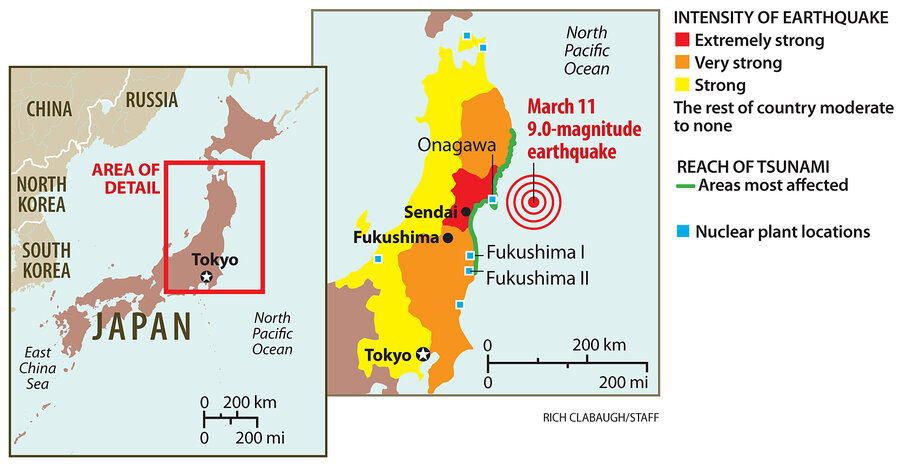Japan nears key fix for nuclear plant, but could it come too late?
Loading...
For embattled workers at a quake- and tsunami-stricken nuclear power plant on Japan's northeast coast, the cavalry may finally be arriving – in the form of electricity from outside the plant to run pumps needed to supply critical cooling water to reactors and spent-fuel pools.
If the electricity arrives in time and workers can prevent the Fukushima I plant's predicament from becoming more grave, the utility faces a long road to what several nuclear engineering specialists say will be the eventual closure of the plant.
In the meantime, US and Japanese officials are increasingly at odds over what is transpiring at the plant and how dangerous its environment has become to workers seeking to gain control over the plant's reactors. Since the 9.0 quake and tsunami deprived the plant of external power, reactors have been beset by partial meltdowns and the buildings damaged by fires and explosions of hydrogen gas. Radioactive steam plumes have risen from the damaged buildings.
Over the past two days, concerns have grown over the status of large, concrete, water-filled pools that provide temporary storage for spent nuclear fuel. In testimony before Congress on Wednesday, US Nuclear Regulatory Chairman Gregory Jazcko told lawmakers that all the water in the spent-fuel pool at the No. 4 reactor likely had run dry.
Japanese officials dispute that. But if Dr. Jazcko is right, that leaves a full core's worth of fuel – removed from the reactor by workers in November during a maintenance outage – to overheat and spew radiation. If the temperature rises high enough, the metal cladding that encases the uranium fuel pellets in the fuel rods can catch fire.
Even absent a fire, radiation leaks from spent fuel in an empty pool are sustained releases, not sporadic, specialists say. According to an account in the New York Times, Jazco added that the higher radiation levels could prevent workers from cooling reactors and stored fuel with seawater and fire hoses.
The arrival of electricity from the wider grid would, in principle, allow workers to pump larger volumes of water into the reactors and empty spent-fuel pools.
Tokyo Electric Power Company (TEPCO), which operates the plant, has nearly finished running a outside power line to the facility, according to company spokesman Naoki Tsunoda.
According to the Associated Press, Mr. Tsunoda said the company would activate the new power line "as soon as possible," although he gave no estimate for how soon plant workers, residents evacuated from the area, and a tensely watching world could expect relief.
With so little specific information coming from the utility about the events over the past few days, nuclear engineers speak only in general terms about what could happen in the coming months if workers succeed in stabilizing the facility.
Job 1 is to continue pumping water to cool cores of the damaged reactors and to maintain adequate water levels in the spent-fuel pools, where the water serves as a radiation shield as well as a coolant. Over time, the need for cooling water decreases as the heat from radioactive decay diminishes, explains Elmer Lewis, a professor emeritus of nuclear engineering at Northwestern University in Evanston, Ill.
The amount of cooling time varies, depending on how long a reactor has been running and how close to maximum power it has come while operating.
One hint comes from fuel-storage practices in the US. Spent fuel must sit in a pool for about a year before it's cool enough to transfer to concrete casks for outdoor storage, according to David Lochbaum, a nuclear engineer who heads the Nuclear Safety Project at the Union of Concerned Scientists in Washington.
But specialists also caution that the picture would be far different if a meltdown has turned the fuel in a reactor partially or wholly into a blob, lacking the channels needed to circulate water, and later air, between and around individual fuel rods.
One of the challenges for plant operators at Fukushima I comes in ending as quickly as possible the release of steam, which contains radioactive gases that are a byproduct of nuclear fission, which drives the reactors.
"As you pump water in, and it boils and turns to steam, you have to relieve the pressure from the steam, and that steam is going to be radioactive," Dr. Lewis says.
Ordinarily, Lewis says, steam is vented through filters that remove radioactive byproducts. But explosions at the plant have allow the steam to vent directly into the air, carrying with it the radioactive gases, including isotopes of iodine and cesium that radiation specialists have associated with serious health problems.
Once the plant's condition has been stabilized, radiation levels near the reactors must fall to a level that will allow workers to survey the damage.
After the accident at Three Mile Island's Unit 2 reactor in 1979, engineers had to wait three years before they could lower a camera into the darkened void of the reactor vessel.
Only then did they discover the true scope of the accident: one-third of the reactor core had melted, says Arthur Motta, a nuclear-engineering professor who chairs the Department of Mechanical and Nuclear Engineering at Penn State University in University Park, Pa. Cleanup of the one reactor took roughly 12 years and cost nearly $1 billion.
For now, however, TEPCO's Fukushima I nuclear power station remains a cascading disaster with few if any straws for workers to grasp.
"Each time you look at the news, you see some new phenomenon taking place that is keeping them from keeping control of the plant," Dr. Motta says. "It isn't good. And now we have two different opinions" on the severity of the crisis, "one from the NRC and one from Japan, and we don't really know which one is correct."
At the request of the Japanese government, a team of experts from the NRC was scheduled to arrive in Japan Wednesday to help the country with the nuclear crisis.





